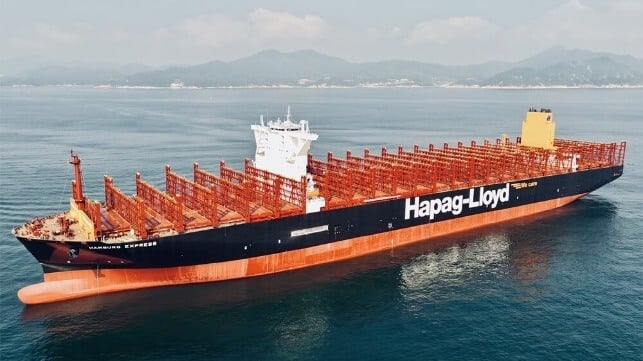Hapag-Lloyd Follows Maersk with Large Methanol Supply Agreement from China

Hapag-Lloyd Follows Maersk with Large Methanol Supply Agreement from China
Germany shipping major Hapag-Lloyd reports it has completed a long-term supply agreement with Chinese energy company Goldwind to ensure a source of green methanol for the long-term power of its vessels. The deal comes almost a year after its soon-to-be partner Maersk completed a similar supply deal with Goldwind.
The new agreement is for the delivery of 250,000 tones of green methanol per year to Hapag-Lloyd. It will consist of a blend of bio- and e-methanol, ensuring greenhouse gas emissions reductions of at least 70 percent according to Hapag. As a company, Hapag-Lloyd aims to reduce the absolute GHG emissions of the fleet by around one-third compared to 2022. Compared to conventional fuels, the company reports the ordered quantity of green methanol can save a total of up to 400,000 tonnes of CO2e emissions in fleet operations per year.
“With the agreement, we are securing a significant proportion of our requirements for green fuels,” said Rolf Habben Jansen, CEO of Hapag-Lloyd. “This will bring us an important step closer to our goal of achieving net-zero fleet operations by 2045. It is and remains our ambition to play a leading role in the transformation of the liner shipping industry.”
Hapag is set to launch its new cooperation called Gemini with Maersk. Both companies have ambitions to be at the forefront of the transition and now both have long-term supply agreements with Goldwind. In November 2023, Maersk signed an offtake agreement calling for annual volumes of 500,000 tons of green methanol. At the time, Maersk called it the first large-scale green methanol offtake agreement for the global shipping industry.
Early volumes of the supply are expected to begin in 2026. Goldwind also plans to build a new green methanol factory adjacent to its existing project in Hinggan League, in northeast China. Goldwind plans to produce the fuels utilizing wind energy.
“The planned new factory will share technology, utilities, facilities, and infrastructures with its neighboring sister plant, boosting production efficiency,” said Liu Rixin, Head of Goldwind Green Methanol. It is still subject to the financial investment decision of the Goldwind board. We anticipate the completion of a megaton green methanol base in Hinggan League in late 2027.”
Maersk highlights the supply will be critical for its fleet of dual-fuel methanol containerships that it is in the process of rolling out. The seventh vessel was named today in Singapore.
Hapag earlier in the month announced a massive $4 billion investment in 24 new vessels. The orders include a dozen 9,000-TEU vessels from New Times Shipbuilding and a dozen 17,000-TEU vessels from Yangzijiang Shipbuilding. The company this month also marked the delivery of number eight in a series of 12 large, 23,660 TEU, LNH containerships being built by Hanwha Ocean (formerly Daewoo) as part of its fleet transition plan. Hapag also converted one in-service vessel starting in 2020 to LNG and recently announced a plan with Seaspan to convert five 10,100 TEU containerships on long-term charter to dual-fuel methanol operations starting in 2026.
Gasum has also agreed to provide Hapag-Lloyd with bio-LNG to fuel containerships sailing between Singapore and Rotterdam in 2025 and 2026. The supply that will meet Hapag’s obligation under its contract with the cargo owners project, ZEMBA, where it won the first bidder for a volume of low-carbon shipping from the buyers alliance that unites major shippers including Amazon, Patagonia, Bauhaus, New Balance, Nike, REI, and others. Gasum will bunker Hapag-Lloyd’s containerships with a total amount of 20,000 mt of bio-LNG during 2025-2026.
